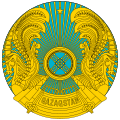Alash Autonomy
Alash Autonomy Алаш Автономиясы | |||||||||||||
|---|---|---|---|---|---|---|---|---|---|---|---|---|---|
| 1917–1920 | |||||||||||||
 | |||||||||||||
| Motto: Оян, Қазақ! Oyan, Qazaq! Проснись, казах! Wake up, Kazakh! | |||||||||||||
 Planned borders of the Alash Autonomy | |||||||||||||
| Status | Unrecognized state | ||||||||||||
| Capital | Alash-Qala | ||||||||||||
| Common languages | Kazakh Russian | ||||||||||||
| Religion | Secular[1] | ||||||||||||
| Government | Republic | ||||||||||||
• 1917-1920 | Alikhan Bukeikhanov | ||||||||||||
| Historical era | Russian Civil War | ||||||||||||
• Established | 13 September 1917 | ||||||||||||
• Disestablished | 17 August 1920 | ||||||||||||
| ISO 3166 code | KZ | ||||||||||||
| |||||||||||||
| Today part of | Kazakhstan Russia | ||||||||||||
Alash Autonomy (Kazakh: Алаш Автономиясы; Russian: Алашская автономия) was a Kazakh state that existed between 1917 and 1920, on approximately the territory of the present-day Republic of Kazakhstan. The capital city was Semey, then known as "Alash-qala" (City of Alash).
Named for the mythical Alash, from whom the three Kazakh tribal confederations claimed to descend, the Alash Autonomy was the first independent Kazakh state to exist since the annexation of the Kazakh Khanate by the Russian Empire in 1848.[2] The state was proclaimed during the Second All-Kazakh Congress held at Orenburg from 5–13 December 1917 OS (18-26 NS), with a provisional government being established under the oversight of Alikhan Bukeikhanov.[3] However, the nation's purported territory was still under the de facto control of the region's Russian-appointed governor, Vasily Balabanov, until 1919. In 1920, he fled the Russian Red Army for self-imposed exile in China, where he was recognized by the Chinese as Kazakhstan's legitimate ruler.[citation needed]
Following its proclamation in December 1917, Alash leaders established the Alash Orda, a Kazakh government which was aligned with the White Army and fought against the Bolsheviks in the Russian Civil War. In 1919, when the White forces were losing, the Alash Autonomous government began negotiations with the Bolsheviks. By 1920, the Bolsheviks had defeated the White Russian forces in the region and occupied Kazakhstan. On August 17, 1920, the Soviet government established the Kyrgyz Autonomous Soviet Socialist Republic, which in 1925 changed its name to Kazak Autonomous Soviet Socialist Republic, and finally to Kazakh Soviet Socialist Republic in 1936.[4]
Government[]
Alash Orda (Kazakh: Алаш Орда, Alash Orda, "Kazakh Horde") was the name of the provisional Kazakh government from 13 September 1917 to 1918. This provisional government consisted of twenty-five members: ten positions reserved for non-Kazakhs and fifteen for ethnic Kazakhs.[5] During their rule, the Alash Orda formed a special educational commission and established militia regiments as their armed forces. They issued a number of legislative resolutions; the first one.
Alongside the authority of the Alash Orda, there sprang up independent Bolshevik councils which opposed the body's rule and aligned themselves with Vladimir Lenin in the brewing Russian Civil War. By 1919, the legitimate government of the Alash Autonomy had been effectively dismantled by Soviet force, its territory being integrated into the nascent Soviet Union. On 17 August 1920, the Kirghiz Soviet Socialist Republic was proclaimed by Lenin and Mikhail Kalinin; this would eventually become the Kazakh Soviet Socialist Republic, and would remain the functioning authority in the region until the dissolution of the Soviet Union in the late-1980s.
Films[]
- 1994 «Алаш туралы сөз» "" "Алаш туралы сөз" - "Алаш туралы сөз" (documentary) «» film director .
- 2009 «Алашорда» "" "Алашорда" - "Алашорда" (documentary) «Kazakhfilm» film director .
- 2018 " Тар заман "- Tar zaman " Strait time" (serial) by Kazakhstan national channel- Қазақстан ұлттық арнасы
See also[]
- Mountainous Republic of the Northern Caucasus
- Turkestan Autonomy
- Turkestan Autonomous Soviet Socialist Republic
- Kazak Autonomous Socialist Republic
References[]
- ^ The Alash Movement and the Soviet Government: A Difference of Positions
- ^ Kesici, Özgecan (19 July 2017). "The Alash movement and the question of Kazakh ethnicity". Nationalities Papers. The Journal of Nationalism and Ethnicity. 45 (6): 1135–1149. doi:10.1080/00905992.2017.1320541. S2CID 135009204. Retrieved 28 July 2020.
- ^ Ubiria, Grigol (16 September 2015). Soviet Nation-Building in Central Asia:The Making of the Kazakh and Uzbek Nations. Routledge. p. 77. ISBN 9781317504351. Retrieved 28 July 2020.
- ^ Peimani, Hooman (2009). Conflict and Security in Central Asia and the Caucasus. ABC-CLIO. p. 124. ISBN 9781598840544. Retrieved 28 July 2020.
- ^ Adle, Chahryar (2005). History of Civilizations of Central Asia: Towards the contemporary period: from the mid-nineteenth to the end of the twentieth century. UNESCO. pp. 255–256. ISBN 9789231039850. Retrieved 28 July 2020.
- Galick, David. Responding to the Dual Threat to Kazakhness: The Rise of Alash Orda and its Uniquely Kazakh Path, Vestnik: The Journal of Russian and Asian Studies (March 29, 2014)
External links[]
- 1917 establishments in Asia
- 1920 disestablishments in Asia
- History of Kazakhstan
- Post–Russian Empire states
- Former countries in Central Asia
- States and territories established in 1917
- States and territories disestablished in 1920
- Kazakhstan geography stubs
